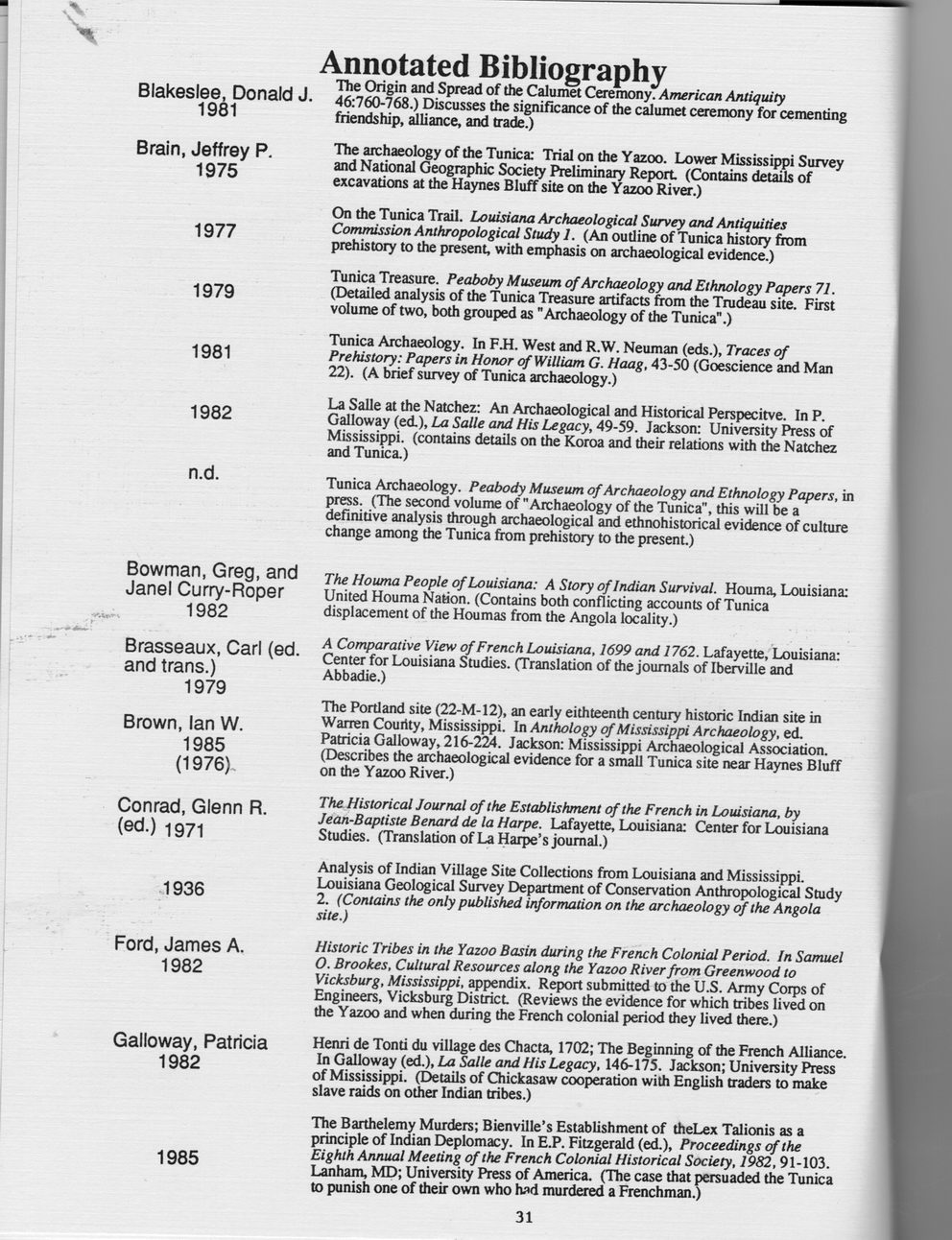This text was obtained via automated optical character recognition.
It has not been edited and may therefore contain several errors.
V Blakeslee, Donald J. 1981 Brain, Jeffrey P. 1975 1977 1979 1981 1982 n.d. Bowman, Greg, and Janel Curry-Roper 1982 Brasseaux, Carl (ed. and trans.) 1979 Brown, Ian W. 1985 (1976), Conrad, Glenn R. (ed.) 1971 1936 Ford, James A. 1982 Galloway, Patricia 1982 1985 Annotated Bibliography The Origin and Spread of the Calumet Ceremony. American Antiquity 46:760-768.) Discusses the significance of the calumet ceremony for cementing friendship, alliance, and trade.) The archaeology of the Tunica: Trial on the Yazoo. Lower Mississippi Survey and National Geographic Society Preliminary Report (Contains details of excavations at the Haynes Bluff site on the Yazoo River.) On the Tunica Trail. Louisiana Archaeological Survey and Antiquities Commission Anthropological Study 1. (An outline of Tunica history from prehistory to the present, with emphasis on archaeological evidence.) Tunica Treasure. Peaboby Museum of Archaeology and Ethnology Papers 71. (Detailed analysis of the Tunica Treasure artifacts from the Trudeau site. First volume of two, both grouped as "Archaeology of the Tunica".) Tunica Archaeology. In FJi. West and R.W. Neuman (eds.), Traces of Prehistory: Papers in Honor of William G. Haag, 43-50 (Goescience and Man 22). (A brief survey of Tunica archaeology.) La Salle at the Natchez: An Archaeological and Historical Perspecitve. In P. Galloway (ed.), La Salle and His Legacy, 49-59. Jackson: University Press of Mississippi, (contains details on the Koroa and their relations with the Natchez and Tunica.) Tunica Archaeology. Peabody Museum of Archaeology and Ethnology Papers, in press. (The second volume of "Archaeology of the Tunica", this will be a definitive analysis through archaeological and ethnohistorical evidence of culture change among the Tunica from prehistory to the present.) The Houma People of Louisiana: A Story of Indian Survival. Houma, Louisiana: United Houma Nation. (Contains both conflicting accounts of Tunica displacement of the Houmas from the Angola locality.) A Comparative View of French Louisiana, 1699 and 1762. Lafayette, Louisiana: Center for Louisiana Studies. (Translation of the journals of Iberville and Abbadie.) The Portland site (22-M-12), an early eithteenth century historic Indian site in Warren Courity, Mississippi. In Anthology of Mississippi Archaeology, ed. Patricia Galloway, 216-224. Jackson: Mississippi Archaeological Association. (Describes the archaeological evidence for a small Tunica site near Haynes Bluff on the Yazoo River.) The Historical Journal of the Establishment of the French in Louisiana, by Jean-Baptiste Benard de la Harpe. Lafayette, Louisiana: Center for Louisiana Studies. (Translation of La Harpe’s journal.) Analysis of Indian Village Site Collections from Louisiana and Mississippi. Louisiana Geological Survey Department of Conservation Anthropological Study 2. (Contains the only published information on the archaeology of the Angola site.) Historic Tribes in the Yazoo Basin during the French Colonial Period. In Samuel O. Brookes, Cultural Resources along the Yazoo River from Greenwood to Vicksburg, Mississippi, appendix. Report submitted to the U.S. Army Corps of Engineers, Vicksburg District (Reviews the evidence for which tribes lived on the Yazoo and when during the French colonial period they lived there.) Henri de Tonti du village des Chacta, 1702; The Beginning of the French Alliance. In Galloway (ed.), La Salle and His Legacy, 146-175. Jackson; University Press of Mississippi. (Details of Chickasaw cooperation with English traders to make slave raids on other Indian tribes.) The Barthelemy Murders; Bienville’s Establishment of theLex Talionis as a principle of Indian Deplomacy. In E.P. Fitzgerald (ed.), Proceedings of the Eighth Annual Meeting of the French Colonial Historical Society, 1982,91-103. Lanham, MD; University Press of America. (The case that persuaded the Tunica to punish one of their own who had murdered a Frenchman.) 31

Native Americans The-Tunica-Biloxi-Tribe-its-Culture-and-People-(39)